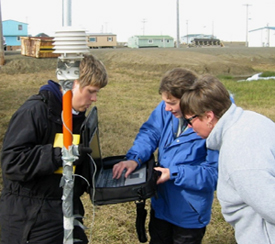11:50 a.m., Nov. 8, 2002--University of Delaware graduate student Anna Klene has been working on a hot topic in a cold place. Klene's work concerns a possible urban heat island in Barrow, Alaska, the northernmost city in the United States.
 |
| Researchers Juli Bell (left), of the University of Cincinnati, and Anna Klene (center) of the University of Delaware, download data with Barrow resident Chris Finkler (right) from the temperature monitoring site in her backyard. |
An urban heat island occurs when temperatures are warmer in town than in the surrounding area.
Klene is working with Frederick E. Nelson, professor of geography at UD, and Kenneth M. Hinkel, professor of geography at the University of Cincinnati, to examine the effects of urbanization in Barrow on local air and soil temperatures as part of the Barrow Urban Heat Island Study (BUHIS). This project has installed 70 sites in and near the village of Barrow that are measuring hourly air and soil temperature.
The study is examining spatial and temporal patterns of air and soil temperature, long-term temperature records, regional temperature trends and mapping the depth of thaw in the summer.
“Barrow is the largest native settlement in the Arctic, with 4,500 residents,” Klene said. “It has the longest air temperature record from the U.S. Arctic beginning in 1921 and has been used extensively in climate change research. Temperature was measured in the middle of town until the late 1980s, though, and we’re investigating if the record is biased because of the influences of human infrastructure and released heat.”
One of the major motivations behind the work is concern about possible thawing of the permafrost underlying the region, due to either urban effects or climate change. Permafrost is any Earth material that stays frozen for more than two years, and northern Alaska has continuous permafrost.
Overlying the permafrost is a thin layer–just a few feet thick–that freezes and thaws each year. Disturbance of the surface can cause the ground to subside, or sink, leading to structural failure.
“We know that air temperature affects how deep the soil thaws in the summer, and because every house, road and pipeline in the Arctic has been engineered so as not to disturb the frozen ground below, there are many implications for urban planning,” Klene said.
“Mapping the depth of thaw hasn't been done before in an urban area and so we’re focusing on that at the moment,” she said, adding, “We’re hoping to refine our results at an international workshop that will be held this November at the conference center in Lewes.”
“This project has been very interesting, getting to know the locals and interacting with the schools and families,” Klene said. “About 30 of our sites are within the town itself, some in volunteers’ backyards, and working with residents made our work a lot of fun.”
Klene’s published work has been getting attention from the international permafrost research community, according to Nelson. Last year she received second place in the Arctic Research Consortium of the United States (ARCUS) international student paper competition for her work in a more remote natural watershed about 200 miles east of the community.
Article by Neil Thomas
Photo by Earl Finkler, courtesy of the Arctic Sounder
|

